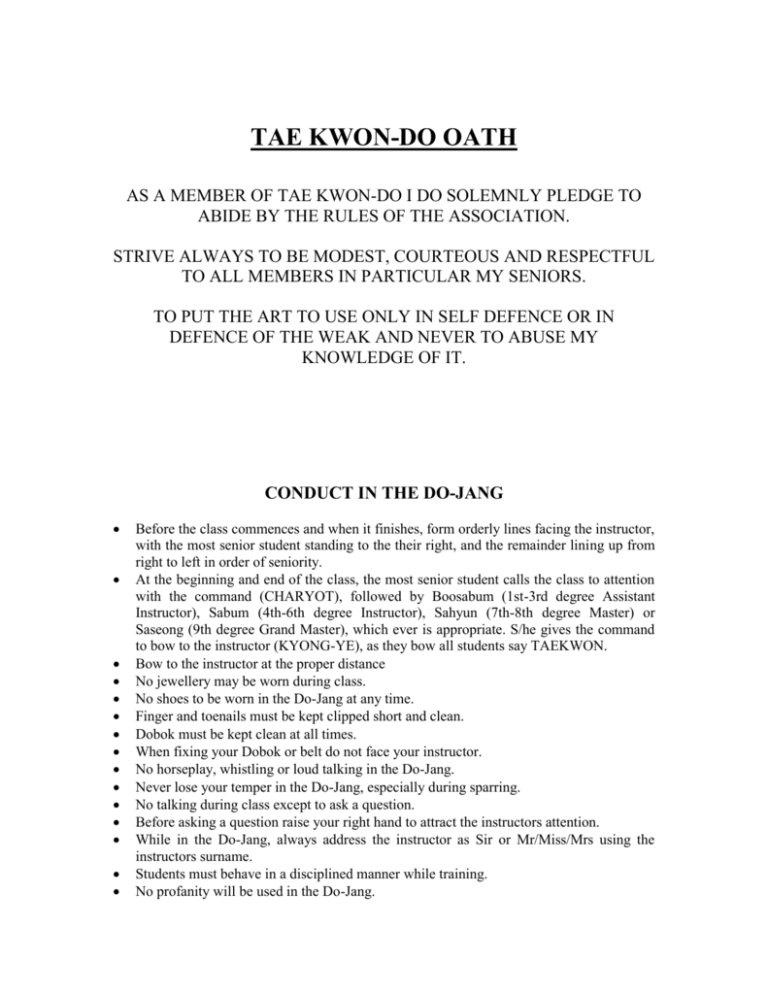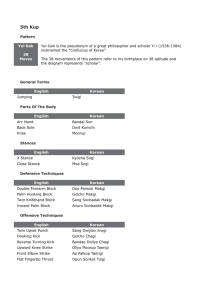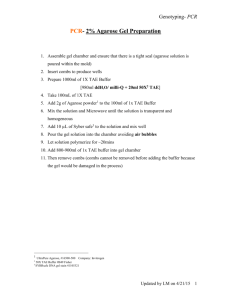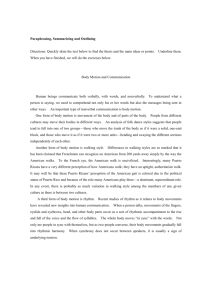TAE KWON-DO OATH
advertisement

TAE KWON-DO OATH AS A MEMBER OF TAE KWON-DO I DO SOLEMNLY PLEDGE TO ABIDE BY THE RULES OF THE ASSOCIATION. STRIVE ALWAYS TO BE MODEST, COURTEOUS AND RESPECTFUL TO ALL MEMBERS IN PARTICULAR MY SENIORS. TO PUT THE ART TO USE ONLY IN SELF DEFENCE OR IN DEFENCE OF THE WEAK AND NEVER TO ABUSE MY KNOWLEDGE OF IT. CONDUCT IN THE DO-JANG Before the class commences and when it finishes, form orderly lines facing the instructor, with the most senior student standing to the their right, and the remainder lining up from right to left in order of seniority. At the beginning and end of the class, the most senior student calls the class to attention with the command (CHARYOT), followed by Boosabum (1st-3rd degree Assistant Instructor), Sabum (4th-6th degree Instructor), Sahyun (7th-8th degree Master) or Saseong (9th degree Grand Master), which ever is appropriate. S/he gives the command to bow to the instructor (KYONG-YE), as they bow all students say TAEKWON. Bow to the instructor at the proper distance No jewellery may be worn during class. No shoes to be worn in the Do-Jang at any time. Finger and toenails must be kept clipped short and clean. Dobok must be kept clean at all times. When fixing your Dobok or belt do not face your instructor. No horseplay, whistling or loud talking in the Do-Jang. Never lose your temper in the Do-Jang, especially during sparring. No talking during class except to ask a question. Before asking a question raise your right hand to attract the instructors attention. While in the Do-Jang, always address the instructor as Sir or Mr/Miss/Mrs using the instructors surname. Students must behave in a disciplined manner while training. No profanity will be used in the Do-Jang. Respect all members of senior grade. Any student who is late for class must get the instructors permission and bow to the instructor before joining the class. Students should never leave class for a break, water or an early dismissal without permission. 10 POINTS TO BECOMING A GOOD TAE KWON-DO STUDENT Never tire of learning. A good student can learn anywhere, anytime. This is the secret of knowledge. A good student must be willing to sacrifice for his art and his instructor. Many students feel that their training is a commodity bought with monthly fees and are unwilling to take part in any demonstrations, teaching or work around the Do-Jang. An instructor can afford to lose this type of student. Always set a good example to lower ranking students. It is only natural that they attempt to emulate their seniors. Always be loyal and never criticise the instructor, Tae Kwon-Do or the teaching methods. If an instructor teaches a technique, practice it and attempt to utilise it. A student's conduct outside the Do-Jang reflects on the art and the instructor. If a student adopts a technique from another Do-Jang and the instructor disapproves, the student must discard it immediately, or train in the Do-Jang where it was learnt. Never be disrespectful to the instructor. TENETS OF TAE KWON-DO Courtesy – Ye Ui Integrity – Yom Chi Perseverance – In Nae Self Control – Kuk Chi Indomitable Spirit – Beakjul Boolgool Courtesy Tae Kwon-Do students should attempt to practice the following elements of etiquette: To promote the spirit of mutual concessions To be ashamed of one’s vice, contempting that of others To be polite to one another To encourage a sense of justice To distinguish the Instructor from student and senior from junior Integrity In Tae Kwon-Do the word integrity means being able to distinguish right from wrong and have the conscience, if wrong, to feel guilt. Listed are some examples where integrity is lacking: The instructor who misrepresents themselves and their art by presenting improper techniques to their students because of a lack of knowledge or apathy. The student who misrepresents themselves by “fixing” breaking materials before demonstrations. The Instructor who hides bad techniques with luxurious training halls and false flattery to his students. The student who requests rank from an Instructor, or attempts to purchase it. The student who gains rank for ego purposes or the feeling of power. The Instructor that teaches and promotes his art for materialistic gains. Perseverance There is an old oriental saying; “patience leads to virtue to merit”. One can make a peaceful home by being patient 100 times. Certainly happiness and prosperity are most likely brought to the patient person. To achieve something, whether it is a higher degree or the perfection of a technique, one must set his goal and then constantly persevere. One of the most important secrets in becoming a leader of Tae Kwon-Do is to overcome every difficulty by perseverance. Self-Control This tenet is extremely important inside and outside the Do-Jang, whether conducting oneself in free sparring or in one’s personal affairs. A loss of self-control in sparring can prove disastrous to both student and opponent. An inability to live and work within one’s capability, or sphere, is also a lack of self-control. Indomitable Spirit “Here lie 300 who did their duty”. A simple epitaph for one of the greatest acts of courage known to mankind. Although facing the superior forces of Xerxes, Leonidas and his 300 Spartans at Thermoplae showed the world the meaning of indomitable spirit. It is shown when a courageous person and his principles are pitted against overwhelming odds. A serious student of Tae Kwon-Do will at all times deal with the belligerent, without any fear or hesitation, with indomitable spirit regardless of whosoever or however many the number may be. About Tae Kwon-Do Tae Kwon-Do is a Korean art of self defence founded by MAJOR GENERAL CHOI HONG HI (9th Dan) on April 11th, 1955 and introduced to Ireland by MASTER RHEE KI HA in 1968. Tae Kwon-Do, translated literally means “the way of the foot and the fist”, is based on traditional Korean Martial Arts. General Choi, after exhaustive researching, developing, and experimenting, proclaimed Taekwon-Do to the world as a completely valid and unique martial art having a basic Korean origin. Translated literally, Tae means jumping or flying, to kick or smash with the foot. Kwon denotes the fist - chiefly to punch or destroy with the hands or fist. Do means art or way - the right way built and paved by the saints and sages of the past. A means of self-defence, physical conditioning and mental discipline, Tae Kwon-Do involves the scientific use of punches, kicks, blocks and dodges, with bare hands and feet, to the rapid destruction of the moving opponent or opponents. Thus, taken collectively “Tae Kwon-Do” indicates the mental training and techniques of unarmed combat for self defence, health and discipline. The DU Tae Kwon-Do Club was established in 1994, and has established itself in competition at home and abroad. Teaching for the DU Tae Kwon-Do Club is provided by Mr. Paul O’Riordan. Training balances teaching of the traditional Martial Art with the self defence and sporting aspects ensuring something for everyone, both male, female, young and old. Tae Kwon-Do is a martial art that has no equal in either power or technique, developed using the principles of modern science. It provides the practitioner with a fine weapon to defend himself or herself. Used wrongly, Taekwon-Do can be a lethal weapon. Therefore mental training must always be stressed to prevent the student from misusing it and promote a strong sense of justice, fortitude, humility, and resolve. Tae Kwon-Do Yoksa (History) Although the origins of the martial arts are shrouded in mystery, we consider it an undeniable fact that from time immemorial there have been physical actions involving the use of the hands and feet for the purpose of self-defence. Many countries throughout the world boast of having developed hand and foot fighting arts, each of which reflects the needs of the time and the varying historical and cultural background of the country where it originated. For example in China Kung Fu; in Japan, Judo, Karate, Aikido or Jujitsu; in Thailand, Thai Boxing or KickBoxing; and in Korea, Taek Kyon, Soo-Bak-Gi and Tae Kwon-Do and so on. Modern Tae Kwon-Do differs greatly from other martial arts, since the theories, Terminology, techniques, systems, methods, rules, practice suit and spiritual foundation were scientifically developed, systematised, and named by General Choi Hong Hi. The physical techniques of Tae Kwon-do are based on the principles of modern science, in particular Newtonian physics which teaches us how to generate maximum power. A combination of circumstances made it possible for Gen. Choi to originate and develop Taekwon-Do. In addition to his prior knowledge of Taek Kyon (one of the earliest forms of Korean martial art which he had been studying since he was fifteen), he had an opportunity to learn Karate in Japan during the period when Korea was occupied by the Japanese. When Korea was liberated in 1945 privileged position as a founding member of the in 1945 he was placed in the privileged position as a founding member of the newly formed South Korean Armed Forces. He began to teach Karate to his soldiers as a means of physical and mental training. It was then that he realised that he needed to develop a Korean national martial art, superior in both spirit and technique to Japanese Karate. He worked tirelessly from that day on until April 11 1955 when he unveiled his new Korean martial art. This new art was named "Tae Kwon-Do". Although Karate and Taek Kyon were used as references in the course of his study, the fundamental theories and principles of Tae Kwon-Do are totally different to those of any other martial art. In 1959, Tae Kwon-Do spread beyond its national boundaries, Gen. Choi and 19 of his top black belts toured the Far East. The tour was a major success, astounding all spectators with the excellence of the Tae Kwon-do techniques. On March 22nd 1966 the International Tae Kwon-Do Federation was formed, comprising of nine national associations i.e. Vietnam, Malaysia, Singapore, West Germany, United States, Turkey, Italy, Republic of Egypt and Korea. The emergence of Tae Kwon-Do as an international martial art in a relatively short period of time was due to a variety of factors. The evils of contemporary society (moral corruption, materialism, selfishness, etc.) had created a spiritual vacuum. For many people Tae Kwon-Do filled that vacuum, and compensated for the prevailing sense of emptiness, distrust decadence and lack of confidence. In addition, the increase of violence and violent crime highlighted the need for self-protection and for many people Tae Kwon-Do filled that need. Tae Kwon-Do Ye Jol (Etiquette) Students, both inside and outside the Do Jang (training hall) should observe a high degree of etiquette. This should be applied by lower ranking students to senior students while training, by higher-ranking students to elder students outside of the Do Jang, and by all students when visiting another Do Jang. In all cases, emphasis should be placed on correct and proper salutation. It is a form of respect and courtesy in Western as well as Oriental societies. It is indeed poor taste for a black belt to slight a beginning white belt that might very well be the instructor's senior in both age and station. Students visiting other Do Jangs, whether they be Tae Kwon-Do or other martial arts, must pay proper respect and observe the traits of modesty and courtesy at all times. PATTERNS (TULS) Patterns are various fundamental movements, most of which represent either attack or defence techniques, set to a fixed logical sequence. In patterns the student systematically deals with several imaginary opponents under various assumptions using every available attacking and blocking toll from different directions. Thus, pattern practice enables the student to go through many fundamental movements in series to develop sparring techniques, improve flexibility of movements, master body shifting and gain rhythmical movements. It also enables the student to acquire certain exercises or sparring. In short, patterns can be compared with a unit tactic, or a word, if fundamental movement is an individual soldiers training or alphabet. Accordingly patterns, the ledger of every movement, are a series of sparring, power tests, feats and characteristic beauty. Though sparring may merely indicate that an opponent is more or less advanced, patterns are a more critical barometer in evaluating an individual’s technique. PERFORMING PATTERNS PATTERNS should begin and end in the same spot. This will indicate the performers accuracy. Correct posture and facing must be maintained at all times. Muscles of the body should be tensed or relaxed at the proper critical moments in the exercise. The exercise should be performed in a rhythmic movement in the absence of stiffness. Each pattern should be accelerated or decelerated according to instructions. Each pattern should be perfected before moving on to the next. Students should know the purpose of each movement. Students should perform each movement with realism THE INTERPRETATIONS OF PATTERNS The life of a human being, perhaps 100 years, can be considered as a day when compared with eternity. Therefore, we mortals are no more than simple travellers who pass by the eternal years of an eon in a day. It is evident that no one can live more than a limited amount of time. Nevertheless, most people foolishly enslave themselves to materialism as if they could live for thousands of years. And some people strive to bequeath a good spiritual legacy for coming generations, in this way, gaining immortality. Obviously, the spirit is perpetual while material is not. Therefore, what we can do to leave behind something for the welfare of mankind is, perhaps, the most important thing in our lives. "Here I leave Tae Kwon-Do for mankind as a trace of man of the late 20th century. The 24 patterns represent 24 hours, one day, or all my life." The name of the pattern, the number of movements, and the diagrammatic symbol of each pattern symbolizes either heroic figures in Korean history or instances relating to historical events BELT COLOURS White Signifies innocence, as that of the beginning student who has no previous knowledge of Tae Kwon-Do. Yellow Signifies Earth, from which a plant sprouts and takes root as the Tae Kwon-Do foundation is being laid. Green Signifies the plant’s growth as Tae Kwon-Do skills begin to develop. Blue Signifies the heaven towards which the plants matures into a towering tree as training in Tae Kwon-Do progresses. Red Signifies danger, cautioning the student to exercise control, and warning the opponent to stay away. Black Opposite of white, therefore signifying the maturity and proficiency in Tae KwonDo. Also indicates the wearers’ imperviousness to darkness and fear. REQUIRMENTS FOR WHITE BELTS (BEGINNNERS) GRADING FOR THEIR YELLOW TAG (9th Kup) (1) (2) (3) (4) 1. 2. Sitting Stance Single Punch (Annun Sogi, Baro Jirugi) 10 Push ups Sajo Jirugi (4 Directional Punch and Low Section Block) Parallel ready stance Walking stance Walking stance forearm low block Walking stance middle front punch Sajo Magki (4 Directional Knife and Middle Block) Walking stance knife-hand low block Walking stance inner forearm middle block Walking Stance (Gunnun Sogi) Walking Stance Middle Punch (Gunnun Sogi, Baro Jirugi) Walking Stance Middle Block (Gunnun Sogi, Bakat Palmok Makgi) Walking Stance Reverse Punch (Gunnun Sogi, Bandae Jirugi) Theory: Terminology and General Information i.e. Tenets, History, Applications of Techniques, Interpretation of Patterns. REQUIRMENTS FOR YELLOW BELTS (8th Kup) All of Previous Syllabus Chon –ji Tul Sitting Stance Double Punch (Annun Sogi, Baro Jirugi, Bandae Jirugi) 20 Press ups Walking Stance Front Kick Double Punch (Annun Sogi, Ap Chagi, Baro Jirugi, Bandae Jirugi) Walking Stance Low Block & High Block Combination (Annun Sogi, Najunde Makgi, Nopunde Makgi) Theory REQUIRMENTS FOR GREEN TAG (7th Kup) All of Previous Syllabus Dan-gun Tul First Four of 3-Step Sparring Semi-Free Sparring Walking Stance Front Kick Double Punch (Annun Sogi, Ap Chagi, Baro Jirugi, Bandae Jirugi) Walking Stance Low Block & Rising Block Combination (Annun Sogi, Najunde Makgi, Nopunde Makgi) Theory REQUIRMENTS FOR GREEN BELT (6th Kup) Anything from Previous Syllabi Do-san Tul 3-Step Sparring (Semi-Free) Free Sparring Measure Up (Right and Left Side Kick, Turning Kick) (Yop Chagi, Dollyo Chagi) Theory Meanings of the Patterns CHON-JI - 9th Kup - Yellow Tip - (19 movements) means literally "the Heaven the Earth". It is, in the Orient, interpreted as the creation of the world or the beginning of human history, therefore, it is the initial pattern played by the beginner. This pattern consists of two similar parts; one to represent the Heaven and the other the Earth. (1) L-stance (2) L-stance inner forearm middle block DAN-GUN - 8th Kup - Yellow Belt - (21 movements) is named after the holy Dan-Gun, the legendary founder of Korea in the year of 2333 BC. (1) Walking stance high front punch (2) L-stance knife-hand middle guarding block (3) L-stance twin forearm block (4) Walking stance forearm rising block (5) L-stance knife-hand middle outward strike DO-SAN - 7th Kup - Green Tip - (24 movements) Is the pseudonym of the patriot Ahn Chang-Ho (1876-1938 ). The 24 movements represent his entire life, which he devoted to furthering the education of Korea and its independence movement. (1) Sitting stance (2) Walking stance outer forearm high side block (3) Walking stance straight fingertip thrust (4) Walking stance backfist high side strike (5) Walking stance outer forearm high wedging block (6) Middle front snap kick (7) Sitting stance knife-hand side strike WON-HYO - 6th Kup - Green Belt - (28 movements) was the noted monk who introduced Buddhism to the Silla Dynasty in the year of 686 AD (1) Closed ready stance A (2) Fixed Stance (3) Bending Ready Stance A (4) L-stance knife-hand high inward strike (5) Fixed stance middle punch (6) Walking stance reverse punch (7) Walking stance Inner forearm circular block (8) L-stance forearm middle guarding block (9) Middle side piercing kick (10) Low front snap kick YUL-GOK - 5th Kup - Blue Tip (38 movements) Is the pseudonym of a great philosopher and scholar Yi I (1536-1584) nicknamed the "Confucius of Korea". The 38 movements o f this pattern refer to his birthplace on 38’ latitude and the diagram (~) represents "scholar". (1) Sitting stance middle punch (2) L-stance twin knife-hand block (3) Walking stance palm middle hooking block (4) Walking stance palm middle reverse hooking block (5) Walking stance front elbow strike (6) X-stance backfist high side strike Walking stance double forearm high block JOONG-GUN - 4th Kup - Blue Belt is named after the patriot Ahn Joong-Gun who assassinated Hiro-Bumi Ito, the first Japanese governor-general of Korea, known as the man who played the leading part in t he Korea- Japan merger. There are 32 movements in this pattern to represent Mr. Ahn's age when he was executed at Lui-Shung prison (1910). (32 movements) TOI -GYE - 3rd Kup - Red Tip is the pen name of the noted scholar Yi Hwang (16th century), an authority on neo-Confucianism. The 37 movements of the pattern refer to his birthplace on 37 latitude, the diagram (~) represents "scholar". (37 movements) HWA-RANG - 2nd Kup - Red Belt is named after the Hwa-Rang youth group which originated in the Silla Dynasty in the early 7th century. The 29 movements refer to the 29th Infantry Division, where Tae kwon-Do developed into maturity. (29 movements) CHOONG-MOO - 1st Kup - Black Tip was the name given to the great Admiral Yi Soon-Sin of the Lee Dynasty. He was reputed to have invented the first armoured battleship (Kobu kson) in 1592, which is said to be the precursor of the present day submarine. The reason why this pattern ends with a left-hand attack is to symbolize his regrettable death, having no chance to show his unrestrained potentiality checked by the forced reservation of his loyalty to the king. (30 movements) KWANG-GAE - 1st Degree (Dan) - Black Belt is named after the famous Kwang-Gae-Toh-Wang, the 19th King of the Koguryo Dynasty, who regained all the lost territories including the greater part of Manchuria. The diagram (+) represents the expansion and recovery of lost territory. The 39 movements refer to the first two figures of 391 AD, the year he came to the throne. (39 movements) PO-EUN - 1st Degree (Dan) - Black Belt is the pseudonym of a loyal subject Chong Mong-Chu (140 0) who was a famous poet and whose poem "I would not serve a second master though I might be crucified a hundred times" is known to every Korean. He was also a pioneer in the field of physics. The diagram ( – ) represents his unerring loyalty to the king and country towards the end of the Koryo Dynasty. (36 movements) GE-BAEK - 1st Degree (Dan) - Black Belt is named after Ge-Baek, a great general in the Baek Je Dynasty (660 AD). The diagram ( I ) represents his severe and strict military discipline. (44 movements) EU I-AM - 2nd Degree (Dan) - Black Belt is the pseudonym of Son Byong Hi, leader of the Korean independence movement on March 1st, 1919. The 45 movements refer to his age when he changed the name of Dong Hak (Oriental Culture) to Chondo Kyo (Heavenly Way Religion) in 1905. The diagram (I) represents his indomitable spirit, displayed while dedicating himself to the prosperity of his nation. (45 movements) CHOONG-JANG - 2nd Degree (Dan) - Black Belt Is the pseudonym given to General Kim Duk Ryang who lived during the Lee Dynasty, 14th century. This pattern ends with a left- hand attack to symbolize the tragedy of his death at 27 in prison before he was able to reach full maturity. (52 movements) JUCHE - 2nd Degree (Dan) - Black Belt is a philosophical idea that man is the master of every thing and decides everything, in other words, the idea that man is the master of the world and his own destiny. It is said that this idea was rooted in Baekdu Mountain, which symbolizes the spirit of the Korean people. The diagram (&) represents Baekdu Mountain. SAM-IL - 3rd Degree (Dan) - Black Belt Denotes the historical date of the independence movement of Korea, which began throughout the country on March 1, 1919. The 33 movements in the pattern stand for the 33 patriots who planned the movement. (33 movements) YOO-SIN - 3rd Degree (Dan) - Black Belt is named after General Kim Yoo Sin, a commanding general during the Silla Dynasty. The 68 movements refer to the last two figures of 668 AD, the year Korea was united. The ready posture signifies a sword drawn on the right rather than left side, symbolizing Yoo Sin’s mistake of following his king’s orders to fight with foreign forces against his own nation. (68 movements) CHOI-YONG - 3rd Degree (Dan) - Black Belt is named after General Choi Yong, Premier and Commander-in-Chief of the Armed forces during the 14th century Koryo Dynasty. Choi Yong was greatly respected for his loyalty, patriotism, and humility. He was executed by his subordinate commanders headed by General Yi Sung Gae, who later become the first king of the Lee Dynasty. (46 movements) YON-GAE - 4th Degree (Dan) - Black Belt is named after a famous general during the Koguryo Dynasty, Yon Gae Somoon. The 49 movements refer to the last two figures of 649 AD, the Year he forced the Tang Dynasty to quit Korea after destroying nearly 300,000 of their troops at Ansi Sung. UL-JI - 4th Degree (Dan) - Black Belt is named after general Ul-Ji Moon Dok who successfully defended Korea against a Tang’s invasion force of nearly one million soldiers led by Yang Je in 612 AD, Ul-Ji employing hit and run guerrilla tactics, was able to decimate a large percentage of the force. The diagram ( L ) represents his surname. The 42 movements represents the authors age when he designed the pattern. MOON-MOO - 4th Degree (Dan) - Black Belt honors the 30th king of the Silla Dynasty. His body was buried near Dae Wang Am (Great King’s Rock). According to his will, the body was placed in the sea "Where my soul shall forever defend my land against the Japanese. It is said that the Sok Gul Am (Stone Cave) was built to guard his tomb. The Sok Gul Am is a fine example of the culture of the Silla Dynasty. The 61 movements in this pattern symbolize the last two figures of 661 AD when Moon Moo came to the throne. SO-SAN - 5th Degree (Dan) - Black Belt is the pseudonym of the great monk Choi Hyong Ung (1520-1604) during the Lee Dynasty. The 72 movements refer to his age when he organized a corps of monk soldiers with t he assistance of his pupil Sa Myung Dang. The monk soldiers helped repulse the Japanese pirates who overran most of the Korean peninsula in 1592. SE-JONG - 5th Degree (Dan) - Black Belt is named after the greatest Korean king, Se-Jong, who invented the Korean alphabet in 1443, and was also a noted meteorologist. The diagram (Z) represents the king, while the 24 movements refer to the 24 letters of the Korean alphabet. TONG-IL - 6th Degree (Dan) - Black Belt denotes the resolution of the unification of Korea which has been divided since 1945. The diagram (I) symbolizes the homogenous race. The following points should be considered while performing patterns: 1. Pattern should begin and end at exactly the same spot. This will indicate the performer’s accuracy. 2. Correct posture and facing must be maintained at all times. 3. Muscles of the body should be either tensed or relaxed at the proper critical moments in the exercise. 4. The exercise should be performed in a rhythmic movement with an absence of stiffness. 5. Movement should be accelerated or decelerated according to the instructions in this book. 6. Each pattern should be perfected before moving to the next Students should know the purpose of each movement. 7. Students should perform each movement with realism. 8. Attack and defense techniques should be equally distributed among right and left hands and feet. There are a total of twenty-four patterns in Tae Kwon-Do. STRIKING Knifehand Inward Outward Back Knuckle TAERIGI Sonkal Anuro Poakuro Dung Joomukanuro BLOCKING Inside Outside Inward Outward MAKGI An Bakat Anuro Bakuro STANCES SOGI Parallel Ready Narani Junbi Walking Gunnun L-Stance Niunja Sogi Fixed Gojung Sitting Annun Attention Charyot KICKING Front Side CHAGI Ap Yop Rising Chookyo Guarding Daebi Knife-Hand Sonkal Outer Forearm Bakat Palmok Inner Forearm An Palmok Knife-Hand Sonkal Daebi (Guarding) Outer Forearm Balkat Palmok Daebi (Guarding) Twin Forearm Sang Palmok Wedging Hecho THRUST Fingertip Elbow Straight Fingertip Back Side Back Elbow TULGI Sonkut Palkup Sun Palkup Dwit Yop Dwit Palkup Turning Back-side Dollyo Poadae Yop PUNCH Obverse Reverse JIRUGI Baro Bandae Forefist Ap Joomuk SECTION High Middle Low Front Side Back DUNGBOON Nopunde Kaunde Najunde Ap Yop Dwit FOOTPARTS HABANSIN Ball Ap Kumchi Footsword Balkal Knee Murup Instep Baltung







